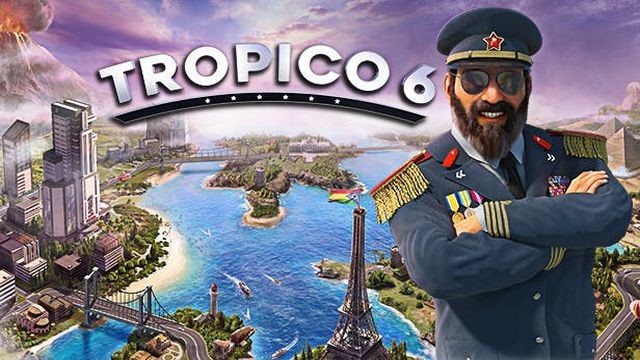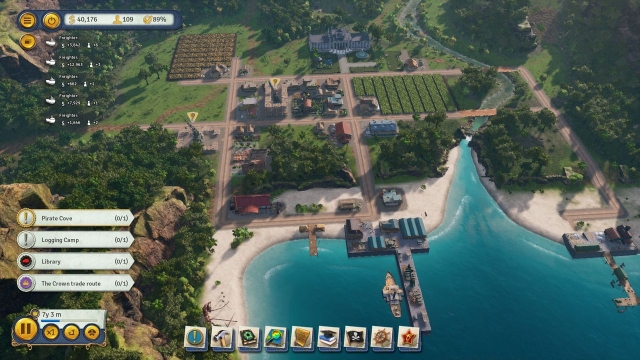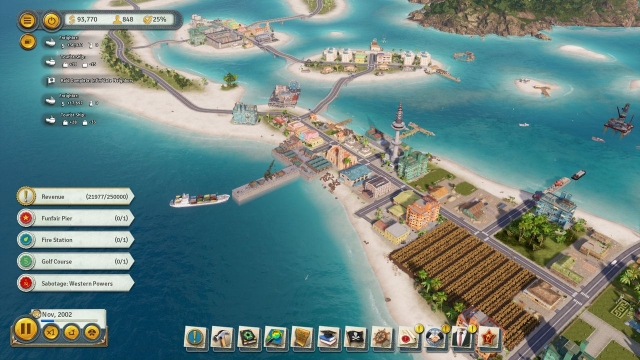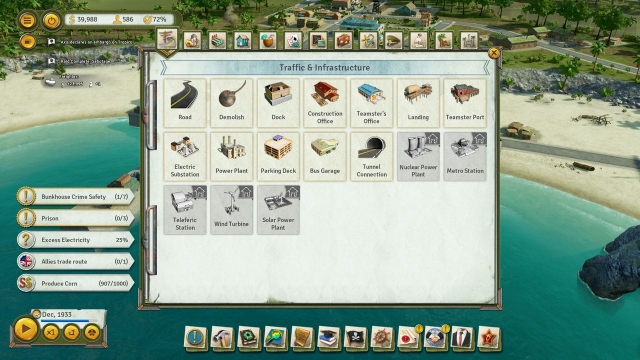Tropico 6

Tropico 6 is the latest installment of the island-themed, city-building franchise. Haemimont Games developed the previous three installments (and their multitude of DLCs), but now they’ve given way to Limbic Entertainment. So is the franchise any different now with a new hand on the tiller? Not in the least. The Tropico games saw major shifts in themes and rules between the other developer changes — most especially between PopTop Software’s original Tropico and Frog City Software’s Tropico 2: Pirate Cove — but Limbic Entertainment seems pretty content to leave things as they are, just adding some new wrinkles and polish to what players have already seen.
If you’ve never played a Tropico game before, your goal is to manage the development of a small Caribbean island. You have to decide what to build and where, you have to keep your citizens happy, you have to make money so you can afford to expand, you have to appease superpowers so they leave you alone (but buy your exports), and, as El Presidente, you have to keep yourself in power, by any means necessary.
A game of Tropico 6 can last for a hundred years or more, potentially starting in the Colonial Era before eventually moving on to Modern Times. The era you’re in determines what buildings and tools you have available to you. When you’re just starting out, you might have to rely on exports like rum and cigars, but as time advances you can gain access to cars, electronics, and (new in Tropico 6) fruit juices. Similarly, your housing, entertainment, and military options also improve, but on the downside, your citizens expect more, so it can be tricky — or maybe just expensive — to keep them happy.
The campaign in Tropico 6 comes with 15 scenarios. As was the case in all of the Haemimont versions of the game, the scenarios are silly, with objectives like smuggling gold in coconuts, kidnapping athletes so you can form a baseball team, and creating a theme park built around squirrels (because dinosaurs are outside your means). I only played nine of the scenarios, and that took me well over 60 hours. Plus, there is also a sandbox mode (with 30 pre-built maps and a random map generator) and multiplayer, so if you enjoy the game, there is plenty of content.
So what’s new in Tropico 6? First off, instead of controlling just one island, you can have multiple islands at your disposal. You’re allowed to build (incredibly cheap) bridges between islands, provided they’re close enough. Otherwise, you can put landing docks on islands, which allow your citizens to grab a boat and sail where they need to go. Luckily, all citizens have access to boats, unlike cars where only the well-off can afford them. Plus, boats are faster than walking, so a trip between islands isn’t necessarily a bad thing.
You also have four “pirate” buildings, one for each era. Pirates can do lots of useful things, including stealing resources, kidnapping people (including educated people), and just generally making money. They can also grab world wonders (like the Statue of Liberty and the Taj Mahal), which you can then turn into entertainment buildings to amuse your citizens.
Unfortunately, Limbic Entertainment went a little overboard with the pirates. Stealing resources means you can skip importing goods, kidnapping educated people means you don’t need to build colleges, and the world wonders are so good that they almost make your other entertainment buildings obsolete. But the worst problem is that you can have your pirates intimidate your neighbors. Your support on the island is based on how happy your citizens are versus how happy your neighbors are, and so the intimidation missions mean you don’t really need to keep your people too happy. You can just wait until it’s election time, and then run an intimidation mission, and suddenly gain a lot of support.
Other additions to the game include a broker who offers you ways to spend the money in your Swiss bank account, buses you can use to transport your citizens around (but unfortunately with only a starting and stopping point rather than a full route), tunnels that give your citizens a way to travel through mountains, blueprints that you need to buy (or steal) before you can construct certain buildings, and a friendly gridded construction interface that makes it easier to place buildings and roads.
Of course, along with changes come bugs. Citizens regularly get stuck in food buildings, and you have to fire them from their job to get them going again. Colleges rarely if ever produce graduates (while, oddly, high schools work fine). Tourism is supposed to provide an alternative way of gaining income, but it always ran in the red for me (I never once had a hotel make money). Loading a saved game always seems to cause problems. And lots of things in the game aren’t explained very well, or at all, like what an alliance with a superpower is supposed to do for you, or why a fire station has a range indicator when your firefighters will travel any distance to put out a fire.
But overall, Tropico 6 is a nice city-builder. It’s a polished game with a friendly interface, and it gives you more things to do than in previous Tropico games (for example, it has about 50% more buildings than the base version of Tropico 5). Tropico 6 currently has some annoying bugs that diminish its fun, but the bugs strike me as the type that can be fixed, rather than turning into “features” at a later date. So if you enjoy city-builders in general or the Tropico games in particular, then Tropico 6 is a worthwhile title to check out.
Reviewed By: Steven Carter
Publisher: Kalypso Media
Rating: 79%
——————————————————————————–
This review is based on a digital copy of Tropico 6 for the PC provided by Kalypso Media.
 Game Over Online
Game Over Online












Never got the appeal of Tropico, to be honest. There are much more sophisticated games out there like Cities (https://rawg.io/games/cities-skylines) or the entire Civilization series (the V is my favourite: https://rawg.io/games/civilization-v)